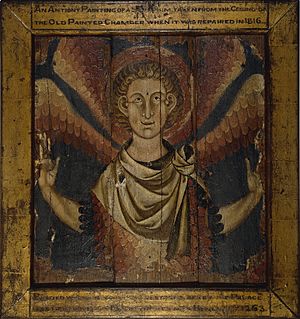Walter of Durham facts for kids

Walter of Durham was a famous painter and artist who lived in England during the 1200s. He worked for two kings, King Henry III and his son, King Edward I. We know about Walter because his name appears in old royal records. His son, Thomas of Westminster, also became an artist, following in his father's footsteps. Walter's most important work was done at Westminster Palace and Westminster Abbey. He decorated the walls and ceiling of a special room called the Painted Chamber. He also painted and added gold to royal tombs and helped build the famous Coronation Chair, which holds the Stone of Scone.
Contents
Walter of Durham: Working for King Henry III
Walter of Durham was already a skilled master painter by the year 1265. At that time, he was painting statues inside Westminster Palace for King Henry III. The next year, in 1266, a fire damaged the palace. Walter helped fix and repaint the murals (wall paintings) in the room that later became known as the Painted Chamber.
In 1270, King Henry III gave Walter a special job, making him the "king's painter" (pictor regis). In those days, a painter often did other jobs too, like carpentry (working with wood). Walter and his team continued to work in the Palace and at Westminster Abbey. They even designed a special boat for the queen, Eleanor of Provence.
Walter of Durham: Working for King Edward I
Walter continued his work at Westminster Palace in 1289, now for King Edward I. He made more repairs to the Painted Chamber in the 1290s.
At Westminster Abbey in the 1290s, Walter decorated the tombs of King Henry III and Eleanor of Castile. Eleanor was King Edward I's wife. Walter also painted a special tomb for Eleanor's heart at a place called Blackfriars.
His last known project was between 1297 and 1300. This was when he painted and built the famous Coronation Chair. This chair is made of wood, painted, and covered in gold. It was placed in Westminster Abbey, near the tomb of Edward the Confessor. The chair was made to hold the Stone of Scone, a special stone that King Edward I took from the Scots in 1296.
Walter of Durham: What's Left of His Work?
Sadly, the Painted Chamber was destroyed by a big fire in 1834. However, before the fire, during some repairs in 1816, four original ceiling panels from the 1200s were taken out. These panels showed a seraph (a type of angel) and three prophets (Isaiah, Jeremiah, and Jonah).
Two of these panels, the seraph and one prophet, were found again in 1993. Experts confirmed they were made by Walter of Durham and his team. The British Museum bought them in 1995. These painted oak panels are some of the oldest examples of English painting on wood that we still have. They show the influence of French Gothic art and a new style compared to the painter who worked before Walter.
One of the decorative pieces from the ceiling is kept at the Sir John Soane's Museum. Even though the original wall paintings are gone, artists made copies of them when they were found in the early 1800s. Charles Stothard made watercolour copies, and Thomas Crofton Croker made another set. These copies are now at the Victoria and Albert Museum and the Ashmoleian Museum. You can also see copies of Walter's tomb paintings, made by E. W. Tristram, in Westminster Abbey today.
Gallery



